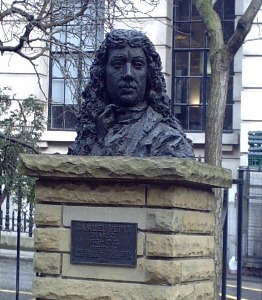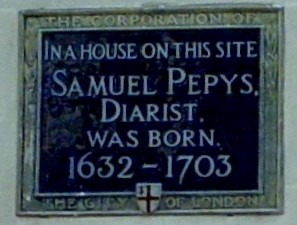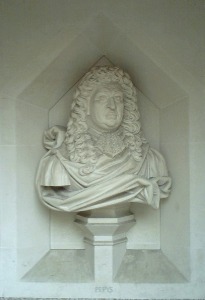
LONDON PEOPLE
Samuel Pepys - Naval Administrator & Diarist 1633 - 1703
london-footprints.co.uk
|
LONDON PEOPLE Samuel Pepys - Naval Administrator & Diarist 1633 - 1703 |
london-footprints.co.uk |
[Introduction] [Life] [Places] [Resources]
Introduction
Samuel Pepys' life spanned a period of profound social
change with momentous events such as Civil War, Restoration,
Plague and Fire. Sociable and hard working he quickly rose to
become secretary to the Navy Board. He enjoyed his spare time
with music, food, drink, women, theatre & literature all
featuring in his famous diary which he wrote between January 1660
and May 1669 in a form of shorthand. Pepys was curious about the
natural world, scientific discoveries and the bustling city where
he lived and worked.
Note on dates
Before 1752 the year officially began on 25 March.
Dates before this can therefore be assigned to the old year or
the new (ie Pepys d.o.b. - see below).
 |
Life Samuel Pepys was born on 23 February 1633 in a house in Salisbury Court (site marked with a plaque). His parents were John Pepys (1601-80), a tailor and Margaret (nee Kite), the daughter of a Whitechapel butcher. Samuel was christened, as were his 8 brothers and sisters, in nearby St Bride's Church. He attended St Paul's School from where he played truant to watch the execution of Charles I in 1649. He left in 1650 and went to Magdalene College, Cambridge obtaining a BA in 1654. Pepys married Elizabeth St Michael, who was only 15, in December 1655 at St Margaret's Westminster. They went to live with a relative, Edward Montagu (later the Earl of Sandwich) for whom Pepys acted as secretary until 1657. |
In March 1658 he underwent the unpleasant procedure of an operation for the removal of a kidney stone. By 1659 Pepys was working in the office of George Downing and living in Axe Yard, Westminster where he started writing his diary in January 1660. Later that year Pepys eventually secured the post of Clerk of the Acts to the Navy Board and moved to Seething Lane. He also went with Montagu to bring back Charles II as monarch.
In 1661 his father retired to Brampton and the following year Pepys was chosen as a younger brother of Trinity House. During the Anglo-Dutch War he proposed a central victualling system and was appointed surveyor-general at a salary of 300 per annum. His work took him to Greenwich where he spent time during the plague year of 1665 whilst his wife stayed in Woolwich. In September of 1666 Pepys witnessed and recorded the Great Fire and was instrumental in saving the Navy Office and St Olave's Church by having nearby buildings pulled down. Fearful that he was losing his eyesight Pepys gave up writing his diary in May 1669. Later that year he and his wife travelled around France and Holland but Mrs Pepys, aged only 29, died of a fever on their return at a house in Crutched Friars. She was buried in St Olave's Church where Pepys erected a memorial to her.
In 1672 he became an elder brother of Trinity House and attended the Westminster Abbey funeral of the Earl of Sandwich, a casualty of the Dutch War. In 1673 Pepys was appointed Secretary for the Affairs of the Navy and following a fire in the Navy Office, moved to temporary lodgings in Winchester Lane. Over the next few years he became Master of Trinity House (1676), Governor of Christ's Hospital (1676), Master of the Clothworkers' Company (1677-8) and a member of the Honourable Artillery Company. In 1677 he persuaded the Commons to finance 30 new ships at a cost of 600,000.
In 1680 he was accused of spying for the French and popery and sent to the Tower. The case was discharged for lack of evidence but Pepys resigned and went to live at 12 Buckingham Street (marked with a plaque) staying until 1688 when he moved to number 14 (until 1700). He was president of the Royal Society, a learned society for the promotion of natural sciences in 1684-6 and as Master of Trinity House in 1685 was responsible for drafting the charter granted by James II. He was appointed Secretary of the Admiralty, a position he held until his retirement in 1689. In the summer of that year he was imprisoned in Westminster Gatehouse on suspicion of treason although he was quickly released due to ill health.
In 1690 he published 'Memoirs of the Navy' and became Treasurer of Christ's Hospital. Pepys went to live at the home of Mr Hewer (formerly his clerk) in 1700 at the Great House on the north side of Clapham Common. It was here that Pepys died on 26 May 1703 but he was buried in St Olave's on 5th June at 9pm as requested. The Archbishop of Canterbury and the Bishop of London attended his funeral. His books were left to be passed on to Magdelene College Cambridge but the diary was not published until 1825.
|
ST OLAVE'S CHURCH Hart Street is a mainly 15th century building with a 13th century crypt. Built in a perpendicular style the brick top to the tower was added in 1732. Pepys referred to as 'our own church'. In 1660 the Navy Board put in its own gallery with access stairs (removed in 1853 but marked with a plaque). This was the site for a memorial to Pepys, designed by Alfred Blomfield and paid for by subscription, eventually put up in 1884. Pepys' tribute to his wife is a bust in an oval niche (1669 by John Bushnell). The church was damaged in WWII and restored by E B Glanfield in 1954. An annual service of commemoration is held in May. The church is usually open 8am - 6pm Monday to Friday. Tel 020 7488 4318. |
| THE NAVY OFFICE was built in Seething Lane in 1656 and was where Pepys lived and worked from 1660. It escaped the Great Fire thanks to his efforts but was destroyed by another fire in 1673 although rebuilt in 1674-5. The building was demolished in 1788 when the office moved to Somerset House. The site is now gardens with a plaque (shown) and a bust of Pepys (pictured in header). |
|
| THEATRES Pepys was an avid theatre-goer (some 338 visits are mentioned in his 9 year diary!). SALISBURY COURT THEATRE was a private theatre built by Richard Gunnell and William Blagrove at a cost of 1000 in 1629. Parliament had closed public theatres in 1642 but plays were illegally performed during the Commonwealth until it was largely destroyed by soldiers in 1649. After the Restoration it was restored by William Beeston and was one of the first theatres to re-open. Samuel Pepys records visiting in September 1661 to see a performance of 'Tis a Pity She's a Whore' - he found the (female) audience more appealing than the play! It was destroyed in the Great Fire of 1666 but its site is marked by a plaque. With the Restoration of Charles II in 1660 theatres were re-established and licences were granted to Thomas Killigrew (the King’s Company) and William D’Avenant (the Duke’s Company). Women were now allowed to perform on stage which must have added to the attraction for Pepys. The DUKE’S THEATRE began in Lincoln’s Inn Fields in a converted tennis court, now the site of the Royal College of Surgeons. Its new home was the Dorset Garden Theatre. This was built on the riverfront in the gardens of Dorset House, which had been destroyed in the Great Fire. The magnificent building by Wren cost 9000 and opened in 1671. Patronised by the upper classes it seated 1000 and became the principal playhouse when Drury Lane burnt down in 1672. However in 1682 the company moved to Drury Lane and the venue was used by wrestlers and other acts. It was renamed the Queen's Theatre in 1689 and demolished in 1709 to become the site of timber yard and later the City of London School playground. Pepys doesn’t appear to have a great liking for Shakespeare but at this time the plays were often ‘adapted’ with happy endings and music & dancing in the tragedies. The general layout of the theatres had the pit with bench seats at 2/6 going back to 4/- boxes. The gallery above was 1/6 and the upper gallery 1/-. Theatre-going was as much about socialising and ‘being seen’ as the play itself especially when the King and court attended. Plague and fire resulted in the closure of public theatres between June 1665 and November 1666. |
|
|
The 17th century PRINCE HENRY'S ROOM at 17 Fleet Street is itself an interesting building, at one time home to Mrs Salmon's Waxworks. The main room has some oak panelling and a Jacobean plaster ceiling decorated with the Prince of Wales' feathers. It has on display items from the trustees of Pepys house at Brampton which were purchased by the Corporation of London in 1985. It is not currently open to the public. |
THE MUSEUM OF LONDON has an exhibition on the Great Fire of London which uses extracts from Pepys' Diary.
 |
In 1971 six new windows donated by the Clothworkers' company were installed in the East Crypt of the GUILDHALL. Depictions include Pepys and the Great Fire of London. There is also a bust of Pepys outside the Guildhall Art Gallery (pictured). |
The site of the house on CLAPHAM COMMON where Pepys died is now within the premises of Trinity Hospice. The gardens are occasionally open under the National Gardens scheme.
Resources
Pepys' Diary (usually in a shortened version) will be
available in bookshops
Deluxe editions have been produced by the Folio Society which has
also published volumes on the Plague and Great Fire. However
these are only available to members [website]
The complete text is available to dowload or read online [website]
There is an excellent website devoted to Pepys' Diary which features daily
entries with annotations plus lots of background information.
Contributions are welcome.
'Restoration London' by Liza Picard is about the practical
details of daily life. It covers the period 1660 to 1670 using
contemporary sources including Pepys' Diary. Published by Phoenix Press.
A biography has been written by Claire Tomalin called 'Samuel
Pepys the Unequalled Self' published by Penguin
There is a Samuel Pepys Club (founded in 1903) with a website
A useless footnote
I went to Addey & Stanhope School in New Cross where the four
houses were Addey (green), Stanhope (blue) Pepys (yellow) and
Evelyn (red). The school song featured verses on each and as most
names were two syllables Pepys was always pronounced Pep-ees. New
teachers who invariably referred to 'Peeps' had to be
re-educated! So if you hear anyone hesitating over their
pronounciation it maybe because they are old Addeyans. I am also
told that the residents of the Pepys estate in Deptford use the
two-syllable pronouciation.
london-footprints.co.uk 2007